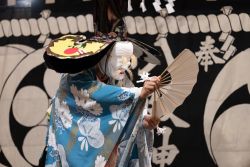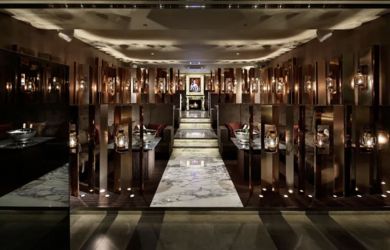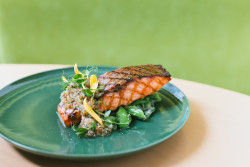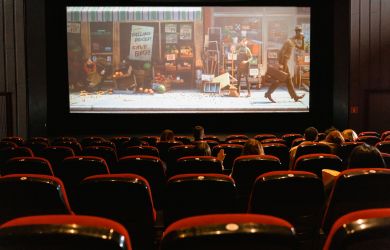
June 2, 2005
Getting to the Roots of Kuala Lumpur
In quiet parks and bustling markets, Malaysia’s capital reveals its past and future
By Metropolis
Originally published on metropolis.co.jp on June 2005

Photos by Tim Hornyak
On a humid Kuala Lumpur evening, few locals can be seen in the tidily kept park at the heart of this teeming capital. Save for a muezzin’s chant floating through the soup-thick air from a nearby mosque, this corner of the Golden Triangle financial district is hushed. But for tourists, this tranquility enhances the jaw-dropping spectacle of the illuminated Petronas Twin Towers looming overhead. The 88-story wonder, until recently the tallest building in the world, is a mesmerizing array of geometric polygons influenced by Islamic architectural tradition. The landmark also gives one pause when considering that the city it stands in was a pestilential jungle basin little more than a lifetime ago.
In Malay, Kuala Lumpur means “muddy confluence,” and this meeting of the Klang and Gombak rivers was only settled in 1857 by Chinese tin prospectors. Today, signs of Muslim Malaysia’s spectacular development, driven by electronics, oil and chemical exports, are ubiquitous in the Japanese cars on the streets, the shining skyscrapers and the housing construction projects. But modern, polyglot Kuala Lumpur (population nearly 2 million) has preserved its roots: Its core features both impressive samples of British colonial architecture and an aging but lively Chinatown.
Getting acquainted with KL, as the capital is widely known, is best done where Malaysia got its start, in Merdeka Square. This is where the Klang and Gombak meet in the heart of downtown and where Malaysia declared its independence from the British in 1957; The site is marked by a 100-meter flagpole, one of the world’s tallest and another of the many superlatives one hears in KL. It was significant that Malaysians chose Merdeka to raise their national flag, as the cricket ground symbolized British sovereignty that had been consolidated since the Straits Settlements of Penang, Malacca and Singapore were set up in 1826 to help protect shipping lanes between India and China.

Merdeka was the focal point for the colonialists, and the buildings fronting the cricket ground show how the rulers longed for their homeland. The exclusive, Tudor-style Selangor Club was where the ruling elite hobnobbed. Next door is the neo-Gothic St. Mary’s Cathedral, which dates to the 1890s. Now home to the high court, the brick-and-mortar Sultan Abdul Samad Building once housed the colony’s administrative offices. By far the most striking part of the square, this fanciful, salmon-colored mixture of Moorish, Mughal and neoclassical styles boasts a 130-meter-tall clock tower amid its shiny copper domes, and looks like something out of a fairy tale.
Ambling around the river delta area presents more movie-set sights. The Kuala Lumpur Railway Station, south of Merdeka, is a palatial Moorish-style terminal built in 1910 by British architect Arthur Benison Hubback, a vision of white minarets and spires. Though still a stop for commuter trains, rail services are now concentrated at the modern KL Sentral Station, and the faded grandeur of the elegant old terminal is certainly worth a look; it’s said to be one of the most-photographed train stations in the world. The Heritage Station Hotel within has Edwardian suites at budget prices, and the adjacent Malayan Railway Administration Building continues Hubback’s Arabian Nights fantasyland theme with arched colonnades, spiral columns and domes. Visitors can see a graceful spiral staircase on the ground floor.
Many of KL’s heritage buildings bear the signature of Hubback, who had worked for the colonial government in India. His love of North Indian motifs is also reflected in his design for the Jamek Mosque, KL’s oldest and the spiritual soul of the capital. Situated on the river confluence proper amid palm groves, this tranquil, striped brick and marble sanctuary is crowned with cupolas and minarets, echoing Hubback’s railway station and equally arresting. Feel free to wander the grounds but check with the custodians first if you’re wearing shorts; you may have to borrow a robe to cover up.
Judging by the national tourism slogan (“Malaysia: Truly Asia”) KL does not disappoint. One of the best places to sample the vibrant ethnic salad of Malays, Chinese and Indians in the capital is Petaling Street, minutes away from the Jamek Mosque. Although it’s the heart of the old Chinatown, Petaling pulsates with a multicultural energy in the form of Malays selling durians, mangosteens and other exotic fruits, Indians hawking T-shirts and belts, and Chinese selling everything from fake Rolexes to pirated movies; one vendor was heard calling, “Watch, sir? Genuine copy!”
The market is bustling but easygoing. Even the police who patrol the crowded lanes give ample time for the DVD sellers to fold up their illegal stalls and melt away into the crowd. The blocks surrounding the covered Petaling Street market are full of old but colorful buildings housing antique shops, Chinese apothecaries and restos serving up Cantonese, tandoori, satays and beyond. Like the Petronas Twin Towers, the market comes alive at night with lights on all the stalls. It seems Kuala Lumpur, dubbed the “Garden City of Lights,” hasn’t forgotten its roots.
Malaysia is hot and humid year-round, with an equatorial climate and temperatures generally ranging from 21-32ºC. Beach-goers, however, should avoid the rainy season from November to January on Peninsular Malaysia’s east coast. Malaysian Airlines operates daily flights from Narita to Kuala Lumpur International Airport. The airline has also just revamped its first and business class services by upgrading its Boeing 747 and 777 cabins with better seat pitches and flat-bed shell seats, along with comprehensively enhancing in-flight services. Accommodations range from the historical Heritage Station Hotel (tel: 603-2272-1688) to the Sheraton Imperial (603-2717-9900). For info, stop by the Tourist Information Center in the Kuala Lumpur Railway Station (603-2274-3125).
[geo_mashup_map]







